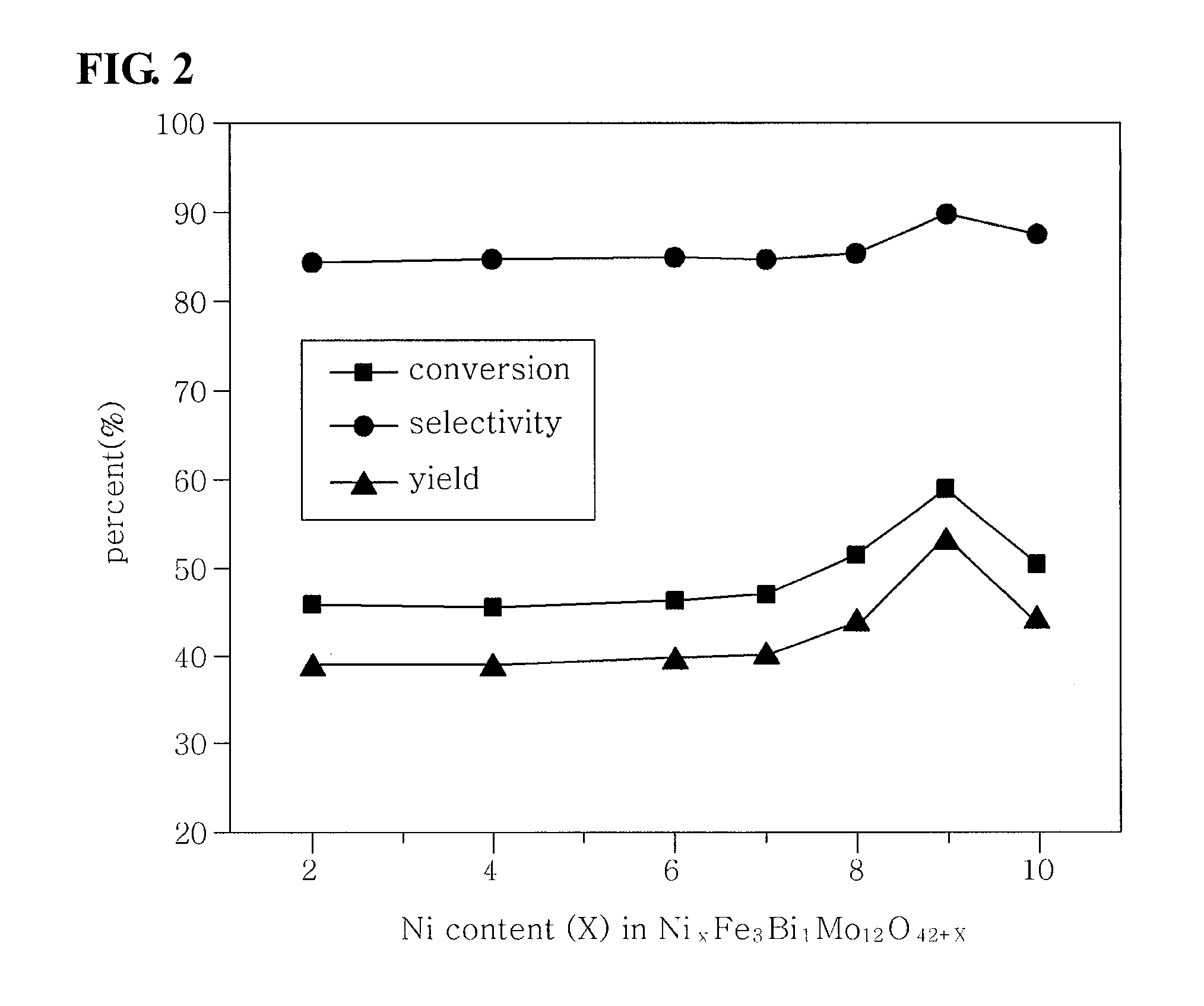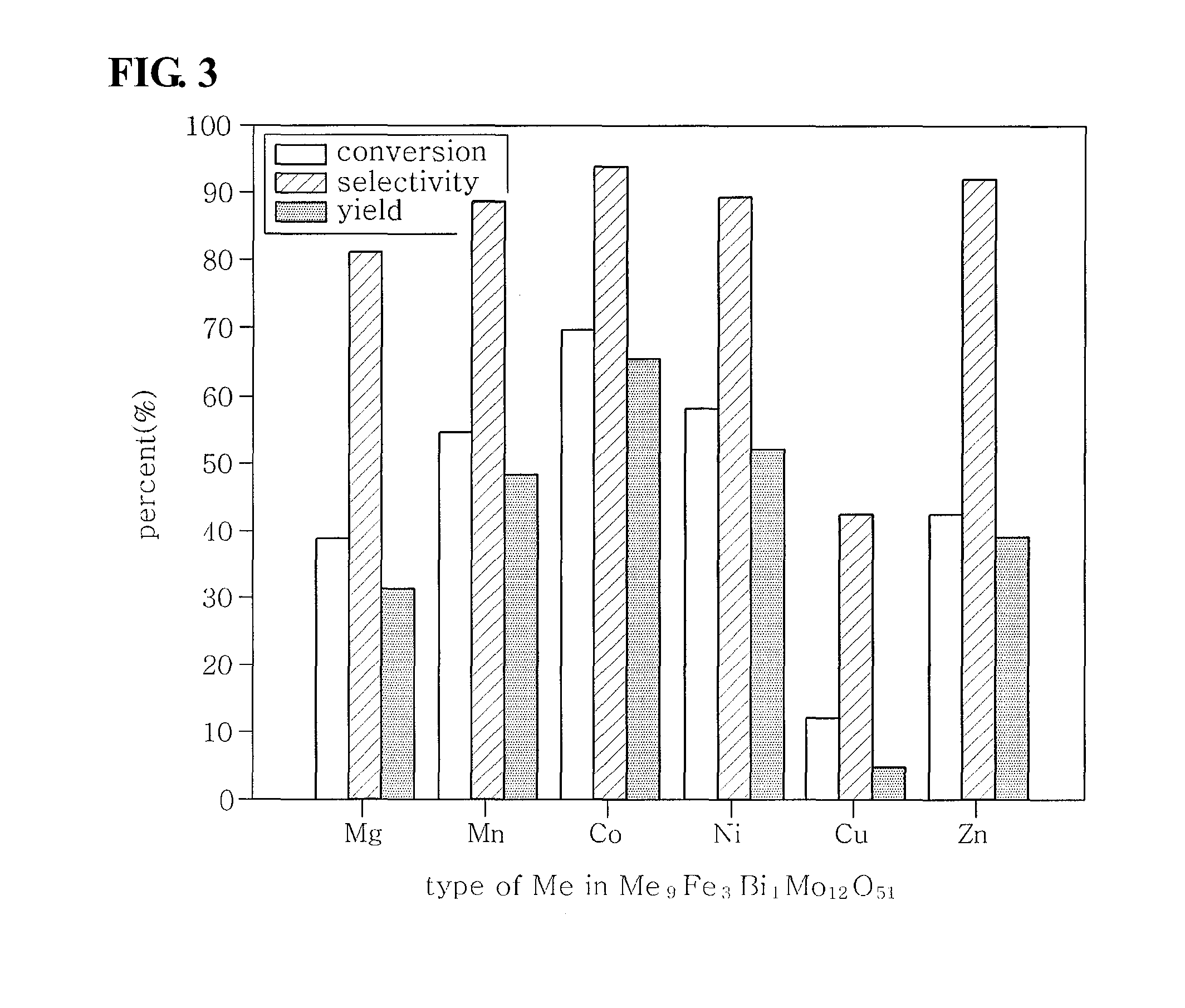Method of preparing multicomponent bismuth molybdate catalysts comprising four metal components and method of preparing 1,3-butadiene using said catalysts
a technology of bismuth molybdate and catalyst, which is applied in the direction of hydrocarbon preparation catalyst, metal/metal-oxide/metal-hydroxide catalyst, physical/chemical process catalyst, etc., can solve the problems of ineffective butadiene increase, inability to effectively meet the demand for butadiene, and disadvantages of direct dehydrogenation of n-butene thermodynamically, etc., to achieve simple composition and synthesis route, high activity, and favorable reprodu
- Summary
- Abstract
- Description
- Claims
- Application Information
AI Technical Summary
Benefits of technology
Problems solved by technology
Method used
Image
Examples
experimental example 1
Oxidative Dehydrogenation of C4 Raffinate-3 or C4 Mixture over Multicomponent Bismuth Molybdate Catalyst
[0045]Using the multicomponent bismuth molybdate catalysts prepared in Preparative Examples 1, 2 and 3, the oxidative dehydrogenation of n-butene was conducted. As reactants, a C4 mixture, air and steam were used, and a straight type Pyrex reactor was used. The composition of the C4 mixture used as the reactant is shown in Table 4 below. The introduction rate of the reactants was set such that the ratio of n-butene:air:steam was 1:3.75:15. The reaction device was designed such that steam was introduced in the form of water to the inlet of the reactor, specifically, water was directly evaporated into steam at 200° C., mixed with the other reactants, that is, the C4 mixture and air, and then introduced into the reactor. The amounts of C4 mixture and air were controlled using a mass flow controller, and the amount of steam was controlled by adjusting the speed of a syringe pump fille...
example 1
Reaction Activity of Multicomponent Bismuth Molybdate Catalysts Composed of Three Metal Components with Different Iron Contents
[0046]The oxidative dehydrogenation of the C4 mixture was conducted according to the process of Experimental Example 1 using the multicomponent bismuth molybdate catalysts composed of three metal components with different iron contents of Preparative Example 1.
[0047]The results are shown in Table 5 below. As the iron content was changed, the formed catalysts had different catalyst phases and ratios and accordingly the surface properties and lattice oxygen properties thereof were varied, resulting in different activities. Further, the effect of the iron content on the activity of the catalyst is depicted in FIG. 1. The yield of 1,3-butadiene was represented by a volcano curve depending on the changes in the iron content, and the greatest activity was exhibited at a molar ratio of iron:bismuth:molybdenum of 3:1:12. Therefore, in the preparation of multicompone...
example 2
Reaction Activity of Multicomponent Bismuth Molybdate Catalysts Composed of Four Metal Components with Different Nickel Contents
[0048]The oxidative dehydrogenation of the C4 mixture was conducted according to the process of Experimental Example 1 using the multicomponent bismuth molybdate catalysts composed of four metal components with different nickel contents of Preparative Example 2. The results are shown in Table 6 below. As the nickel content was changed, the formed catalysts had different catalyst phases and ratios and accordingly the surface properties and lattice oxygen properties thereof were varied, resulting in different activities. Further, the effect of the nickel content on the activity of the catalyst is shown in FIG. 2. The yield of 1,3-butadiene was represented by a volcano curve depending on the changes in the nickel content, and the greatest activity was exhibited at a molar ratio of nickel:iron:bismuth:molybdenum of 9:3:1:12. Therefore, in the preparation of mul...
PUM
| Property | Measurement | Unit |
|---|---|---|
| Temperature | aaaaa | aaaaa |
| Temperature | aaaaa | aaaaa |
| Temperature | aaaaa | aaaaa |
Abstract
Description
Claims
Application Information
 Login to View More
Login to View More - R&D
- Intellectual Property
- Life Sciences
- Materials
- Tech Scout
- Unparalleled Data Quality
- Higher Quality Content
- 60% Fewer Hallucinations
Browse by: Latest US Patents, China's latest patents, Technical Efficacy Thesaurus, Application Domain, Technology Topic, Popular Technical Reports.
© 2025 PatSnap. All rights reserved.Legal|Privacy policy|Modern Slavery Act Transparency Statement|Sitemap|About US| Contact US: help@patsnap.com



